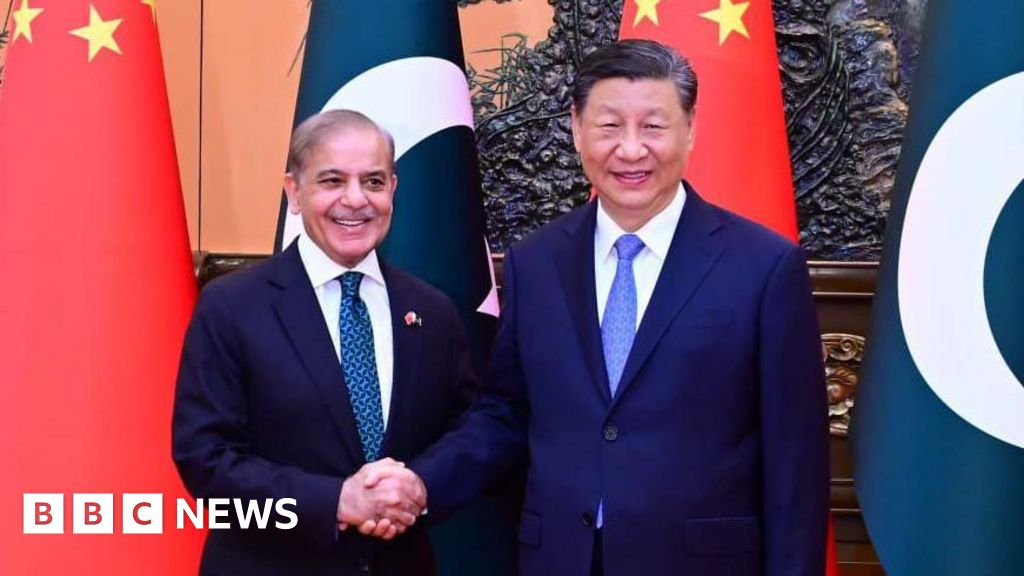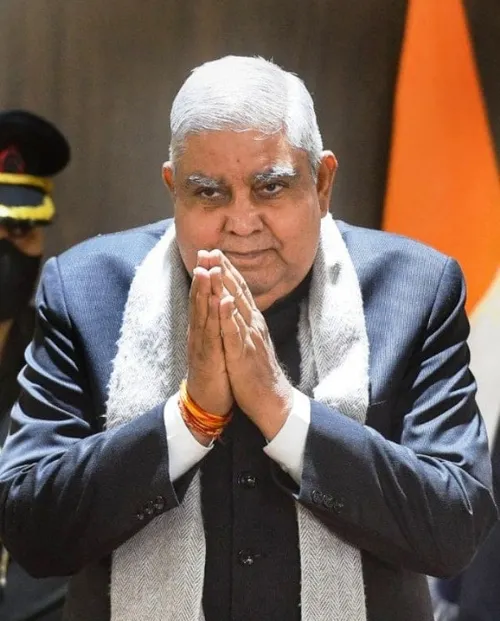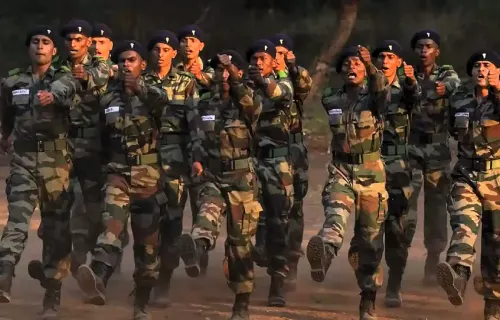South Asia Regional Editor
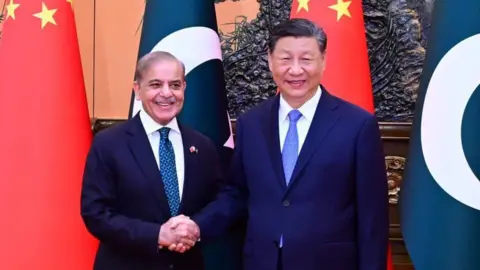 X/Shehbaz Sharif
X/Shehbaz SharifThe four-day conflict between arch-rivals India and Pakistan this month ended with a ceasefire and both claiming victory – but it now appears that China’s defence industry might also be an unlikely winner.
The latest flare-up began on 7 May when India launched attacks on what it called “terrorist infrastructure” inside Pakistan in response to the brutal killing of 26 people, mostly tourists by militants in Pahalgam on 22 April.
Many of them were killed in the scenic valley in Indian-administered Kashmir in front of their wives and family members. Delhi accused Islamabad of supporting militant groups involved in the carnage, a charge Pakistan denied.
After India’s response – which it called Operation Sindoor – to the militant attack, tit-for-tat military manoeuvres from both sides followed, involving drones, missiles and fighter jets.
India reportedly used its French and Russian-made jets, while Pakistan deployed its J-10 and J-17 aircraft, which Islamabad co-produces with Beijing. Both sides say their jets did not cross the border and they were firing missiles at each other from a distance.
Islamabad claims that its fighter aircraft shot down at least six Indian planes, including the newly-acquired French-made Rafale fighter jets. Delhi hasn’t responded to these claims.
“Losses are a part of combat,” Air Marshal AK Bharti of the Indian Air Force (IAF) said last week when a reporter asked him about these claims. Air Marshal Bharti declined to comment on the specific claim of Pakistan downing Indian jets.
“We have achieved the objectives that we selected, and all our pilots are back home,” he added.
India said it had killed at least “100 terrorists” while targeting the headquarters of the banned Lashkar-e-Taiba and Jaish-e-Mohammed militant outfits based in Pakistan.
A definitive account of what really happened in the aerial battle is yet to emerge. Some media outlets reported plane crashes in the state of Punjab and Indian-administered Kashmir around the same time but the Indian government has not responded to the reports.
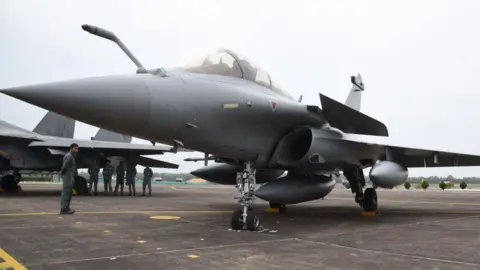 Getty Images
Getty ImagesA Reuters report quoting American officials said Pakistan possibly had used the Chinese-made J-10 aircraft to launch air-to-air missiles against Indian fighter jets. Pakistan claiming victory after hugely relying on Chinese weapons systems in an active combat situation is being seen by some experts as a boost for Beijing’s defence industry but some also disagree with the claim.
Some of the experts have called this a “DeepSeek moment” for the Chinese weapons industry, referring to January this year when the Chinese AI start-up shook US giants with its cost-effective technology.
“The aerial fight was a big advertisement for the Chinese weapons industry. Until now, China had no opportunity to test its platforms in a combat situation,” Zhou Bo, a retired senior colonel in the Chinese People’s Liberation Army, told the BBC.
The Beijing-based analyst said the outcome of the air duel showed “China has some systems that are next to none”. Shares in the Chinese Avic Chengdu Aircraft company, that manufactures fighter jets like the J-10, surged by up to 40% last week after the reported performance of the fighter jet in the India-Pakistan conflict.
Other experts, however, feel it’s too early to declare the superiority of Chinese weapons systems.
Professor Walter Ladwig from the King’s College in London said it was yet to be determined whether the Chinese jets had actually outmanoeuvred the Indian Air Force (IAF) planes, particularly the Rafale.
“In a standard military doctrine, you would suppress the enemy’s air defences and get air superiority before you struck ground targets. Instead, it appears the IAF’s mission was clearly not to provoke any Pakistani military retaliation,” he said.
Mr Ladwig thought that the Indian pilots were given instructions to fly despite the fact that the entire Pakistani air defence was on high alert and their jets were already in the sky. The IAF hasn’t given details of the mission or about its air operations strategy.
Beijing also hasn’t made any comment on reports of the J-10 taking down Indian fighter jets, including the Rafale. But unconfirmed reports of the J-10 bringing down a Western weapon system has triggered jubilation and triumphalism on Chinese social media.
Carlotta Rinaudo, a China researcher at the International Team for the Study of Security in Verona, said Chinese social media was flooded with nationalistic messages even though it’s difficult to reach a conclusion with the available information.
“At the moment perception matters way more than reality. If we see it in that way, the main winner is really China,” she said.
For China, Pakistan is a strategic and economic ally. It is investing more than $50bn (£37bn) to build infrastructure in Pakistan as part of its China-Pakistan Economic corridor.
So, a weak Pakistan is not in China’s interest.
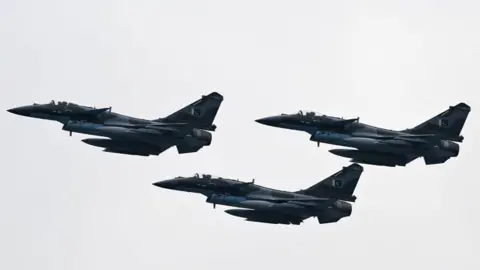 AFP
AFPChina made a critical difference in the latest India-Pakistan conflict, says Imtiaz Gul, a Pakistani security analyst. “It took the Indian planners by sheer surprise. They didn’t probably envision the depth of co-operation in the modern warfare between Pakistan and China,” he said.
Experts say the performance of the Chinese jets in a real combat situation was keenly analysed in Western capitals as this will have cascading impact on global arms trade. The US is the world’s largest arms exporter, while China is the fourth.
China sells weapons mostly to developing countries like Myanmar and Pakistan. Previously the Chinese weapon systems were criticised for their poor quality and technical problems.
Reports said the Burmese military grounded several of its JF-17 fighter jets – jointly manufactured by China and Pakistan in 2022 – due to technical malfunctions.
The Nigerian military reported several technical problems with the Chinese made F-7 fighter jets.
Another point to be noted is that this was not the first time that India lost an aircraft to Pakistan.
In 2019, during a brief air battle between the two sides following similar Indian air strikes on suspected terrorist targets in Pakistan, a Russian-made MiG-21 jet was shot down inside Pakistani territory and the pilot was captured. He was released a few days later.
India, however, said that the pilot had ejected after successfully shooting down Pakistani fighter jets, including a US-made F-16. Pakistan has denied the claim.
Despite reports of the downing of Indian jets last week, experts like Mr Ladwig argue that India was able to hit an “impressive breadth of targets” inside Pakistan early in the morning of 10 May and this fact has gone largely unnoticed by the international media.
The Indian military said in a co-ordinated attack, it launched missiles on 11 Pakistani air bases across the country, including the strategic Nur Khan air base outside Rawalpindi, not far from the Pakistani military headquarters. It’s a sensitive target that took Islamabad by surprise.
One of the furthest targets was in Bholari, 140km (86 miles) from the southern city of Karachi.
Mr Ladwig says this time the IAF operated with standard procedures – first attacking Pakistani air defence and radar systems and then focusing on ground targets.
The Indian jets used an array of missiles, loitering munitions and drones despite the Pakistanis operating the Chinese-provided HQ 9 air defence system.
“It seems the attacks were relatively precise and targeted. The craters were in the middle of runways, exactly the ideal spot. If it were a longer conflict, how long would it take the Pakistani Air Force to get these facilities up and running again, I can’t say,” Mr Ladwig pointed out.
Nevertheless, he said, by refusing to get into the details of the mission briefing, India’s military “lost control of the narrative thread”.
 Reuters
ReutersIn response to the Indian strikes, Pakistan said it launched missile and air strikes on several Indian forward air bases, but Delhi said the attacks caused no damage to equipment and personnel.
Realising that the situation was getting out of control, the US and its allies intervened and put pressure on both countries to stop the fighting.
But for India, experts say, the whole episode is a wake-up call.
Beijing may not comment on the details of the recent India-Pakistan conflict, but it’s keen to show that its weapon systems are fast catching up with the West.
Delhi is aware that the jets China has supplied to Pakistan are some of the earlier models. Beijing has already inducted the more advanced J-20 stealth fighter jets, that can evade radars.
India and China have a long-standing border dispute along the Himalayas and fought a brief border war in 1962 that resulted in a defeat for India. A brief border clash took place in Ladakh in June 2020.
Experts say India is acutely aware that it needs to accelerate investments in its homegrown defence manufacturing industry and speed up international buying.
For now, China’s defence industry seems to be enjoying the limelight following the claims of success of one of its aircraft in the India-Pakistan conflict.
Follow BBC News India on Instagram, YouTube, Twitter and Facebook
Anurag Dhole is a seasoned journalist and content writer with a passion for delivering timely, accurate, and engaging stories. With over 8 years of experience in digital media, she covers a wide range of topics—from breaking news and politics to business insights and cultural trends. Jane's writing style blends clarity with depth, aiming to inform and inspire readers in a fast-paced media landscape. When she’s not chasing stories, she’s likely reading investigative features or exploring local cafés for her next writing spot.
